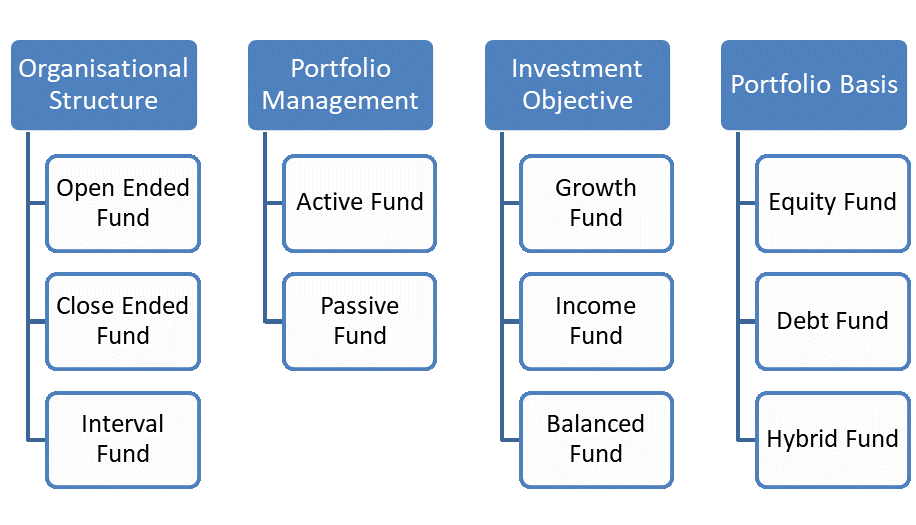These days’ investors are switching from traditional investment instruments like FD, RD, PPF etc to Mutual funds. Mutual Funds have given lucrative returns as compared to low interest rates provided by traditional products.
If you want to invest in mutual funds but you don’t know what are Mutual funds and their benefits, this article is for you.
What is Mutual Fund?
Mutual fund is basically is pool of money collected from various investors and invested in various capital and money market instruments.
- Every Mutual Fund scheme is created on specific objective and invests the money accordingly in different instruments to achieve that objective.
- Fund manager manages the funds on behalf of investors and takes appropriate decisions on investment.
- Funds are regulated by Securities Exchange and Regulations Board (SEBI).
- Manager invests money in different instruments to diversify the portfolio so that risk can be diversified.
- Fund is divided into units of equal value and Portfolio is valued on per unit basis (NAV).
Benefits of Mutual Funds
- As Mutual Funds have a basic goal to achieve, so, one can choose scheme as per his investment goal.
- One can choose Mutual Fund schemes as per his risk apatite and investment objectives from a wide variety of schemes.
- Mutual Funds have low transaction cost.
- Mutual Funds give compounding returns which are more than return given by traditional instruments.
- These are convenient and easy to transact. You can purchase and redeem units online through DMAT account, Mobile App or through visiting a broker.
- As portfolio of a Mutual fund is diversified it helps to reduce risk.
- As Mutual Funds are regulated by SEBI so investor’s interest is protected.
- There are some specific schemes which provide income tax and indexation benefits.
- Mutual Funds have lowest time span of three years as compared to any instrument to save income tax.
There are plenty of Mutual Fund schemes available. Each Mutual Fund scheme is different from other on the basis of their portfolio. But we categorize them to compare on some similar characteristics. Below are the types of Mutual Funds:

Also read: Understand SIP : Systematic Investment Plan – Step toward wealth creation
Based on Organizational Structure
Open Ended Fund
Open Ended funds do not have a fixed maturity date. These types of fund offer units for the first time during a New Fund Offer (NFO) and thereafter, these can be purchased and redeemed at any time.
As these funds can be purchased and redeemed anytime therefore unit capital for these funds is also not fixed.
Closed Ended Fund
Closed ended funds operate for a pre-defined period. These funds are offered in NFO and closed for further purchase.
All the units are redeemed on a pre-defined maturity date and scheme comes to close on that pre-defined date. The size of the closed ended fund remains constant throughout.
Interval Fund
These funds are a variety of closed ended funds. They are basically closed ended funds but become open ended fund at specific intervals. Investor can purchase or redeem units during this specific interval only. Duration for this specific transaction period is minimum 15 days.
Also read: How to select best mutual fund scheme
Classification Based on Portfolio Management
Active Fund
Active funds are the funds in which fund manager works actively to gain higher returns at a higher fee. Active funds are mainly sought to beat a benchmark.
Fund Manager uses various strategies to attain the stated investment objective of the scheme. These strategies are based on the risks and returns associated with individual stocks, sectors or the market.
Passive Fund
In opposite Passive funds are the replica of a benchmark Index fund or Exchange Traded Funds.
Also read: Understand the difference between Direct and Regular Mutual Fund
Classification Based on Investment Objective
Growth Funds
Main objective of the Growth Funds is to provide capital appreciation over medium to long term. Growth funds are basically a type of equity funds. These funds have a portfolio of equity shares.
These funds are more volatile than any other income or liquid funds.
Income Funds
Main objective of these funds is to generate regular income, on a monthly or quarterly basis.
These funds mostly invest debt instruments issued by the government, companies, banks and financial institutions. These funds carry interest rate risk and Credit risk.
Balanced Funds
Balanced funds are a balance of growth and income oriented securities. Balanced fund consist both asset class in portfolio, equity and debt.
There objective is to provide regular income and growth with some protection from volatility. A balanced fund’s risk is related to its exposure to equity.
Classification Based on Investment Portfolio
Equity Fund
Equity Mutual funds invest in equity and equity related instruments.
An investor who require a high rate of return, have a long investment horizon and able to take short term volatility risk associate with stock market can invest in equity mutual funds.
Equity funds can be further classified as Diversified Equity Funds, Sector Specific Funds and Thematic Equity Funds.
Also read: Do you want to know about Equity Fund
Debt Funds
Debt mutual funds mostly invest in debt securities such as Treasury Bills, Government Securities, Bonds and debentures.
These securities have a fixed maturity date and pay a specific rate of interest. An investor who seeks capital protection can invest in debt funds. Debt funds inherit interest rate risk.
Higher the time horizon of investment there is higher the risk.
Also read: Lets Know All About Debt Mutual Funds
Hybrid Funds
Hybrid funds have equity and debt funds in some proportion.
Equity oriented balanced funds have 65% or more exposure in equity and rest in debt securities. Whereas debt oriented balanced funds invest 65% or more in debt securities and rest in equity.
Other Types of Mutual Funds
Gold Exchange Traded Funds
Gold ETF have the gold as underlying asset. These funds have price linked to the gold price index. Each Gold ETF unit is equal to one gram of gold. NAV and price of Gold ETF unit always moves along with the movement in price of gold on metal exchange.
Arbitrage Funds
These funds earn the carry cost implicit in the difference between the cash and the derivatives markets. Fund manager buy in the spot market and sell in the derivative market, to earn the interest rate differential. As this a hedged position therefore, these funds have a low risk investment proposition.’
International Funds
International funds invest in market outside their parent country by holding one or more of the following:
- Equity or debt of companies listed abroad
- ADRs and GDRs of a company
- ETF of other countries
- Units of passive index funds or actively managed mutual funds in other countries.
These funds may also hold some of their portfolio in their country’s equity and debt.
Equity Linked Saving Schemes (ELSS)
ELSS are special equity funds, investment in which is eligible for tax deduction under section 80 c of the income tax act. These funds must hold at least 80% of the portfolio in equity securities.
These funds have a lock in period of 3 years from the date of investment.
Rajiv Gandhi Equity Saving Scheme (RGESS)
RGESS is aimed to encourage small investors having annual income up to 12 lakh and who have never invested in Mutual funds or equity market by providing them tax benefits. An investment up to Rs 50,000/- in eligible securities is eligible for one time deduction under section 80CCG.
Fund of Funds (FoF)
A Fund of Funds invests its corpus in other funds. Its portfolio holds other funds of the same fund house, or other fund houses.
Now you have an idea about the types and classification of various mutual funds. Basically we divide mutual funds on their portfolio basis equity, debt or balanced mutual funds.
These can be further divided based on their portfolio. You can select any of the above as per your requirement.

